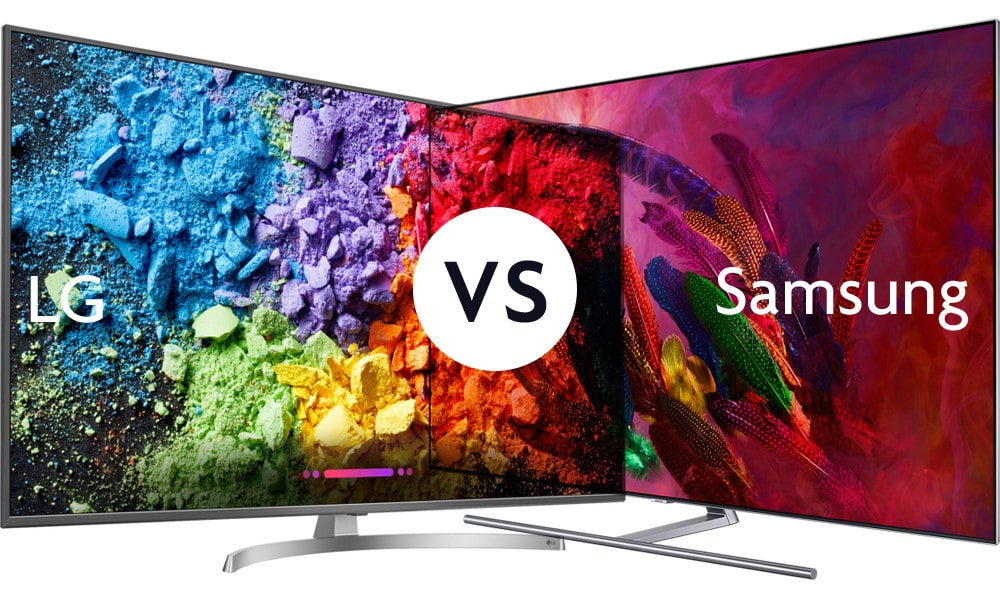A large percentage of TVs sold worldwide are made by two companies, LG and Samsung. Some of their models appear in our TV ratings, including the Best TVs of 2022. We compare the two companies below to help you decide which company makes the right TV for you.

LG vs. Samsung
LG and Samsung are both based in South Korea, but they have significant differences when it comes to the TVs they produce. The biggest difference is in display type. Historically, LG has sold TVs with OLED (organic light-emitting diode) screens, while Samsung has opted to use LED (light-emitting diode) and QLED (quantum-dot light-emitting diode) screens. That said, Samsung released its first OLED TV in more than a decade in 2022, and LG has released a quantum-dot-based technology it calls QNED.
Another difference is the smart TV operating system each company incorporates into its TVs. Samsung uses its Tizen OS, whereas LG relies on WebOS. Both Tizen and WebOS have apps for all the major streaming services, although neither is as common as the Android or Roku platforms.
Given that Samsung and LG TVs function have similar features, we suggest you decide between the two based on display technology. If you prefer a brighter picture, Samsung’s QLED sets are the way to go. However, if you want a better contrast ratio (where blacks look black and not gray) and a wider viewing angle, we recommend an OLED TV from LG.
Understanding the differences between the displays on LG and Samsung TVs requires understanding the differences between LED, OLED, and QLED.
Both light-emitting diodes (LED) and quantum-dot light-emitting diodes (QLED) work similarly in that LEDs are used to light up a backlit LCD panel. However, a QLED display adds a layer of semiconductor particles called quantum dots that enhance colors compared to a traditional LED set.
LED displays are brighter than OLED displays, but they can’t display perfect blacks because they use a backlight that’s always on. As a result, even dark scenes will be dark gray rather than black. That said, a QLED display will show deeper blacks than a standard LED display.
In an OLED display, each pixel emits light on its own and doesn’t require a backlit panel. This means the brightness and color of each pixel can be controlled individually. Because each pixel can be turned off completely, an OLED display can be completely black rather than dark gray, which improves contrast and can result in a better picture overall. On the downside, OLED displays generally don’t last as long as LED displays.
In summary, OLED displays offer wider viewing angles and deeper blacks than QLED displays, and they’re also thinner and more energy-efficient because each pixel is controlled individually. However, QLED displays offer higher peak brightness. You’ll need to decide whether contrast or brightness is more important when choosing a display type.
The LG TVs that made our list, the LG C1 and G1, both use OLED display technology. The Q80A, QN85A, and QN90A Samsung TVs use QLED technology instead.
All our recommended LG and Samsung TV models are intended for medium to large-sized rooms. The LG C1 has a 48-inch model available. However, the smallest G1 model is the 55-inch. The largest size available is the 83-inch G1.
The Samsung Q80A and QN90A offer 50-inch models, with a 55-inch model the smallest QN85A available. If you’re looking for a big TV, look no further than the QN90A, which tops out at a massive 98 inches.
Pros
- LG uses OLED displays that have perfect blacks
- LG's ThinQ AI works better in searching for content than Tizen
- OLED is better for dark viewing environments
Cons
- High-end OLED TVs are more expensive than comparable QLED TVs
- OLED is less impressive than Samsung's QLED in bright rooms
- OLED TVs don't last as long as Samsung's LED TVs
- Tags:
- samsung









LG offers better viewing angles and webOS, while Samsung has better gaming features and brighter HDR. Both offer excellent picture quality.
Personally, I own Samsung in my home of 55 inches. I like the pros and cons of this article.